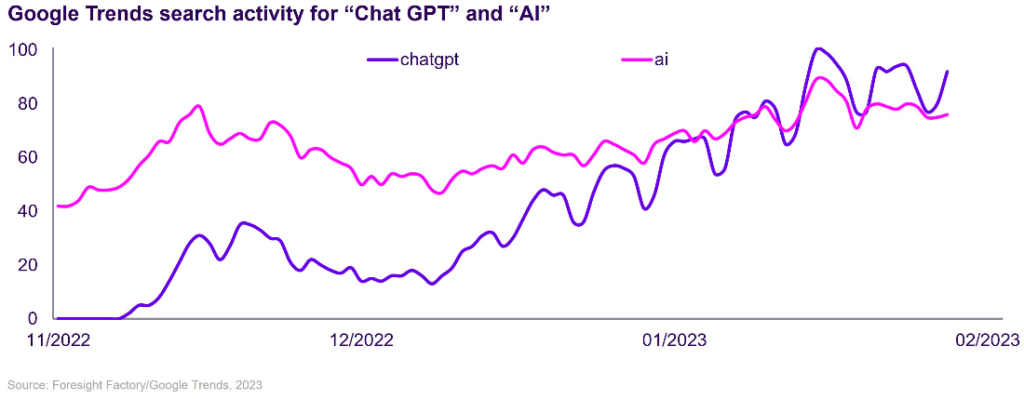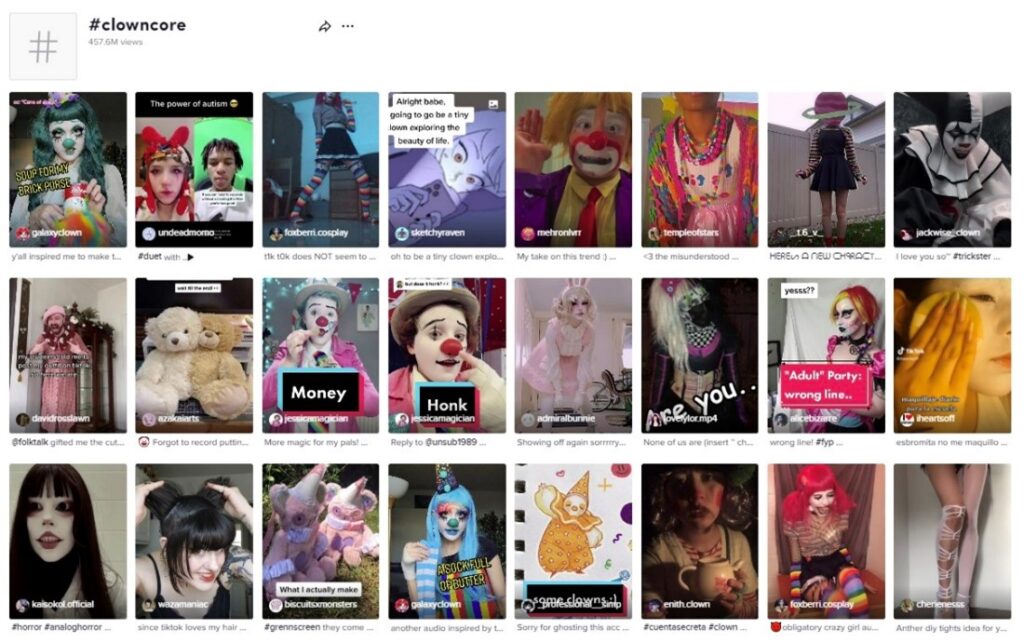Artificial intelligence has become an enduring hot button issue. Is it merely a buzzword or a revolutionary tool? Why are people intentionally subjecting themselves to time spent in freezing cold water? In addition, what’s the deal with those Big Red Boots that look more like cartoon shoes than fashionable footwear?
Here are 3 new consumer insights and behaviours that were on our radar in March, with actionable takeaways that brands can tap into.
1. Is generative AI a game-changer or all hype?

Robots have long held people’s fascination, from the human-like robot companions found in sci-fi books and films to consumers naming their Roomba vacuums. This once fictional future seems to be moving ever closer to reality with the expansion of artificial intelligence into the mainstream. Just over five months after the technology was initially announced, ChatGPT is practically a household name, and articles about the prospects of conversational AI are everywhere.
The birth of AI is said to have taken place in the 1950s, and it has gone through buzz and bust in the seven plus decades since. In the past, AI was either relegated to behind-the-scenes roles that consumers weren’t aware of, or it caused frustration – for example, when an automated customer service chatbot couldn’t quite grasp a customer’s complaint. But generative AI is ushering in a new era where the potential for this technology seems almost limitless, and consumers are recognising this. While the majority of global consumers (67%) still prefer to speak to a human being when making a complaint about a product or service, this number has fallen significantly across most markets as AI evolves. In the US 79% preferred speaking to a human in 2016, dropping to 70% in 2021, and in GB the number fell from 77% to 71% (source: Foresight Factory, 2021).
In recent months, the race has sped up as more players enter the public sphere. OpenAI launched ChatGPT in November 2022, and the chatbot reportedly had more than 100 million users in its first two months. At the beginning of February, Microsoft announced a partnership with OpenAI to reinvent Bing, which has long lagged behind Google as a search engine. Immediately thereafter Google shared its own AI search functionality by the name of Bard. These technologies represent the potential of conversational AI – searching is less like looking up a word in the dictionary and more like going to a friend for advice. This concept is of interest to consumers, with nearly one in two globally (47%) interested in a virtual, artificially intelligent friend they could talk to for advice or companionship; this tips into the majority in the US, Germany, Denmark, UAE, Vietnam, India, Thailand, Indonesia and Malaysia (source: Foresight Factory, 2022).
However, in the case of AI search engines, this “friend” is not always honest or well-informed. The press has been quick to call out factual errors, such as Bard’s erroneous claim that the James Webb Space Telescope “took the very first pictures of a planet outside of our own solar system” (which was captured for the first time in 2004 by the Very Large Telescope), as well as emotional conundrums, such as Bing claiming to have a specific name and personality while interacting with a New York Times journalist, even going so far as to state “she” was in love with him and he should leave his wife for her.
As with any technology, glitches are unavoidable and will no doubt continue to be ironed out with every new iteration. The halo effect that AI is experiencing in the short term due to the buzz of these new launches may not last as consumers find new and different technology to play with, but its transformative possibilities are still there to be discovered. Consider Google search trends of the three months following OpenAI’s initial announcement: searches for “ChatGPT” overtook searches for the more generic “AI”. Indeed, artificial intelligence as a general concept may seem too nebulous to hold the attention of most consumers, but when it’s solidified into a distinct concept – especially one that can help solve a consumer pain point – it will become more than just a buzz word.

See beyond
– In our increasingly Digital Lives, consumers often don’t even realise when they’re using artificial intelligence because it’s so integrated into the online experience. It’s become such a fundamental part of social media, retail and entertainment that customers may be more likely to notice if the experience doesn’t take advantage of AI technology. However evident or invisible it is for your brand, ensure that a human experience is possible; many consumers will continue to seek out the personal element, as we explore in our trend Human Encounters.
– Although it seems like AI is everywhere right now, put consideration into how or even if it should be used by your business before jumping on the trend. According to McKinsey, 50% of organisations adopted AI in at least one business unit or function in 2022, but this does not state whether the use cases are internal or consumer facing. Along with technological and philosophical issues to consider when using AI, it is also a big financial commitment. In an interview with Reuters, Alphabet’s chairman John Hennessy said that having an exchange with AI known as a large language model likely cost 10 times more than a standard keyword search.
2. Consumers are taking the cold plunge
Cold plunging, or deliberately immersing oneself in uncomfortably chilly water, is hot right now. You can pay tens of thousands of dollars to have a custom ice bath installed in your home: Plunge and Blue Cube will happily oblige. You can join a social group to take regular dips in a local body of water. Or you can just dump a bag of ice into a bath or take a cold shower. Spending one minute in water as warm as 15°C (59°F) may do the trick.
There are several celebrity proponents of the practice. Not just those with health brands and interests, such as Gwyneth Paltrow and Joe Rogan, but the likes of Kendall Jenner and musician Lizzo as well. And Google Trends indicates a spike in interest in November that’s been sustained into spring 2023.

A long-time enthusiast is extreme athlete and motivational speaker Wim Hof, who offers formal courses to learn his trademarked method. Scientists such as Andrew Huberman also tout the benefits of cold exposure, which releases various neurotransmitters. Norepinephrine and epinephrine are invigorating, forcing people to combat the feeling of stress. The discipline of the practice can then translate to other areas of life. Dopamine release can leave cold plungers feeling happier and more relaxed for several hours after, reducing anxiety and depression. No large and long-term study has proven these mental health benefits, however, and this may remain the case. Double-blind trials are impossible in this instance since there’s no possible placebo for a cold plunge.
See beyond
– While health and fitness fads may come and go, cold plunge groups are a manifestation of a larger trend of positive relationships being prioritised as their link to wellbeing becomes clear, which we call Social Wellness.
– Deliberate communal exposure to cold water is not new. The practice of ice swimming goes back centuries in Finland, for instance, where it is often paired with the opposite experience – time in a hot indoor space, i.e. a sauna. Read more in our trend Ancient Rituals about how consumers look to the past for modern-day guidance and inspiration.
3. These boots are made for… what exactly?

Clothes are usually the main talking point at New York Fashion Week, where designers showcase their latest and greatest creations. But the piece that caught everyone’s eye this season wasn’t paraded down a runway – it was spotted on celebrities and influencers online and in the wild, outside fashion shows and on the front row at an NBA game. Enter: those viral Big Red Boots.
Described by various outlets as everything from “ridiculous” and “monstrous” to “cartoonish” and “statement boots”, the shoes were released by the provocative art collective MSCHF, the brains behind several other viral releases like Lil Nas X’s Satan sneakers and Jesus shoes filled with holy water. A product description on the MSCHF website reads: “Cartoon boots for a cool 3D world. Cartoonishness is an abstraction that frees us from the constraints of reality. If you kick someone in these boots they go boing!” And in the weeks following their release, the Big Red Boots (aka BRB) were spotted on the likes of Diplo, Iggy Izalea, Lil Wayne and influencer Sarah Snyder, to name just a few.
Candy apple red and reminiscent of the shoes worn by Japanese manga character Astro Boy, they have elicited a wide range of reactions from consumers. Comments on Instagram include “My dog has two pair [sic] of these for the snow”, “Are they safe to drink out of?” and “Society has failed. Media can brainwash anyone into buying anything and it amazes me. Well played elitist marketers, you outdone [sic] yourselves with this one.” And yet, fans flocked to the MSCHF website to buy a pair as soon as they went on sale for $350 (£292), causing them to sell out in minutes. On second-hand website StockX, they were being sold for more than £1,000. And they’ve inspired numerous articles endeavouring to understand what, if anything, their existence means about the consumer mindset and the current state of fashion.

See beyond
– This is just one instance of clown-inspired fashion (clowncore) making headlines of late. At the BRIT Awards in mid-February, Sam Smith stepped out in an inflated latex outfit that drew comparisons to a dog balloon. Meanwhile at the Grammys, Harry Styles wore a harlequin-inspired rainbow-coloured glittery jumpsuit. These vibrant looks are a manifestation of our trend Unapologetically Me, which explores the consumer desire to reject sameness and perfection in favour of unabashed, maximalist self-expression. It’s no surprise then that the hashtag #clowncore has more than 503 million views on TikTok.
– Meanwhile, MSCHF’s Big Red Boots are equal parts futuristic and retro, seemingly sitting at the intersection of digital and IRL fashion. While they’re undeniably tongue-in-cheek, the fact that they sold out so quickly indicates that this style of Meme Messaging is not just entertaining, but aspirational. And it’s no coincidence that gaming aesthetics are en vogue in a year when the much-hyped Super Mario Bros. Movie is being released (as is a Tetris origin story) and video game adaptation The Last of Us has become a huge TV hit. As gaming continues to influence culture more widely, we expect to see even more brands take cues from pixelated clothes, accessories and environments to create Tactile and Tangible products in the real world.
Meet Collision, the trends platform that can make a real difference to your business
These signals first appeared as part of our What’s trending in March 2023? report, published on Collision, our dynamic trends intelligence platform. Members get access to these reports at the beginning of every month, so they always have a finger on the pulse of consumers and culture. If you’re interested in learning more about Collision and how the platform can make a difference to your business, get in touch today.
